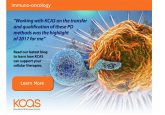Quantitative immunochromatographic test could aid diagnosis of early heart attack and sepsis
Scientists, led by Alexander Osipov (NUST MISIS; Moscow, Russia), have developed a quantitative immunochromatographic test which could identify blood markers, enabling early diagnosis of heart attack, sepsis, pregnancy and viral and bacterial infections.
Alexander Osipov (NUST MISIS) commented: “We have improved the technology used for rapid testing. It is now possible to not only identify the presence of certain substances in the body but also to determine their critical number visually. To get a quantitative result, it is necessary to apply one or several drops of a biosample to the test strip and count the number of colored test lines appearing in the device’s analytical area.”
Osipov explained: “Biological samples flow on the test strip segment that contains a conjugate labeled with gold nanoparticles or quantum dots of antibodies. Then the test strip captures the sample and moves with it along an analytical membrane. The resulting immunocomplexes move along several cross lines containing a second set of antibodies against the defined antigens in increasing concentrations.
“The binding of labeled immunocomplexes on the carrier, which is visually registered as forms of colored cross lines on the test strip, occur due to the specific interactions of antibody and antigen. The higher the content of the determining substance in the sample, the greater the number of lines that will appear in the analytical area. Using this approach to analyze things like human chorionic gonadotropin in urine allows responders to determine not only the presence, but also the stage of a pregnancy.”
Osipov concluded: “Monitoring fatty-acid-binding proteins (FABP) is the most promising way to diagnose early heart attacks. When the heart is damaged, the concentration of FABPs in the blood increases significantly in the first hours after symptoms appear. The simultaneous determination of early FABP and late cardiac markers with the use of our new type of rapid-test increases the efficiency of diagnoses and allows doctors to identify hidden forms of heart attacks.”
Sources: Samsonova JV, Safronova VA, Osipov AP. Pretreatment-free lateral flow enzyme immunoassay for progesterone detection in whole cows’ milk. Talanta 132:685–689 (2015); https://phys.org/news/2018-01-rapid-early-heart-diagnosis-sepsis.html






